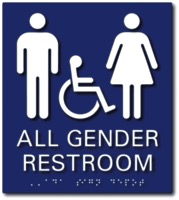
I spend a lot of money at coffee houses. I don’t eat out a lot, or drink alcohol at all; coffee is my major vice. I notice when I go to a local coffee house, or a chain coffee house like Starbucks, how they have their restroom stalls marked.
As of March 1 of this year, business entities that have single stall restrooms, according to Health and Safety Code 118600, should be identified as all-gender restrooms. California’s Health and Safety Code 118600 was changed by 2016’s AB-1732. If businesses had their single stall bathrooms marked male and female, they had five months to change these to all-gender.
Quoting Equality California’s fact sheet for AB-1732, “A 2013 survey and report published by the Williams Institute at the UCLA School of Law found that gender specific restrooms pose serious risks to transgender and gender non-conforming individuals. Due to bias and discrimination, 70 percent of survey respondents had reported being verbally harassed, denied access or physically assaulted in public restrooms.”
There were other reasons listed in the bill in its text, but with Equality California and the Transgender Law Center being two of the bill’s initial four sponsors, it was pretty clear the main reason for the bill was transgender people’s safety.
Cost is minimal for all-gender signage for each single stall restroom. If a restroom already is marked all-gender or unisex, according to the AB-1732 the signage doesn’t have to change.
So in the past few weeks, it surprised me when I frequented three Starbucks that still had male and female restroom signage instead of all-gender signage. On all occasions, I spoke to the on-duty manager or someone behind the counter about the restroom signage being out of compliance with California code. When I went back to these Starbucks a week or more later the signage hadn’t changed.
There is two ways to handle this from there. The government officials tasked with enforcing the code are health inspectors who may check this “during any inspection of a business or place of public accommodation by a health officer or inspector … but does not require those inspectors to do so.” State health inspectors as a group don’t want this job.
“While health officers recognize the need to ensure equitable restroom access to every individual,” wrote the Health Officers Association of California in opposition to AB-1732 (as included in the text of the AB-1732), “public restroom signage falls outside of the health officers’ purview. As introduced, [this bill] would create the expectation that health officers should inspect restroom signage in every business or place of public accommodation. This is greatly outside of the health officers’ scope, and is an issue that does not require the health officers’ medical and public health expertise.”
I could’ve called or emailed the San Diego County Department of Environmental Health’s Food Facility Inspection division and filed a complaint. I decided not to go that route.
The other choice would be to contact the corporate offices at Starbucks.
“We have already retrofitted 92 percent of our company operated stores in California with gender-neutral bathroom signage,” said a Starbucks spokesperson in response to a media request, “and are working diligently to ensure full compliance with this code. From our earliest days, we have strived to create a company and culture that treats everyone – partners and customers alike – with respect and dignity. We have always believed in equal treatment of all individuals and have a long history and commitment to our LGBTQ partners and community.”
This is one corporate chain of food and beverage establishments among many corporate chains in California with single stall restrooms in their businesses. How many are 100 percent compliant, and who’s checking and commenting?











